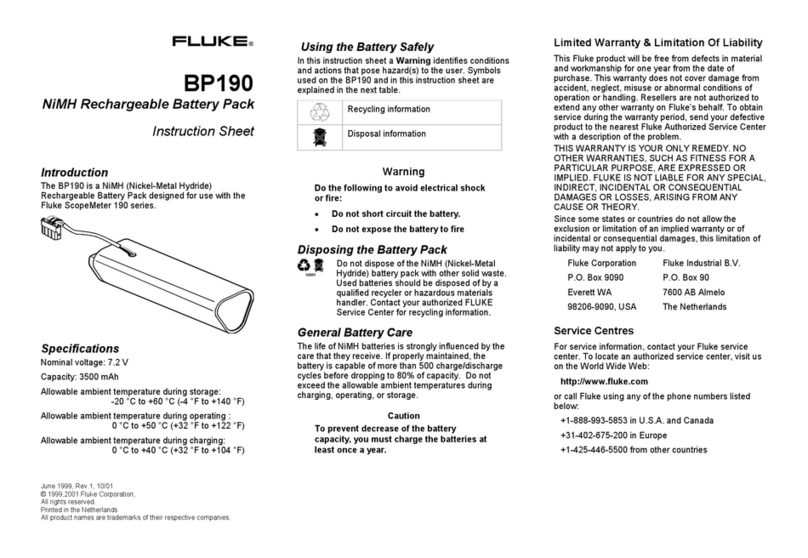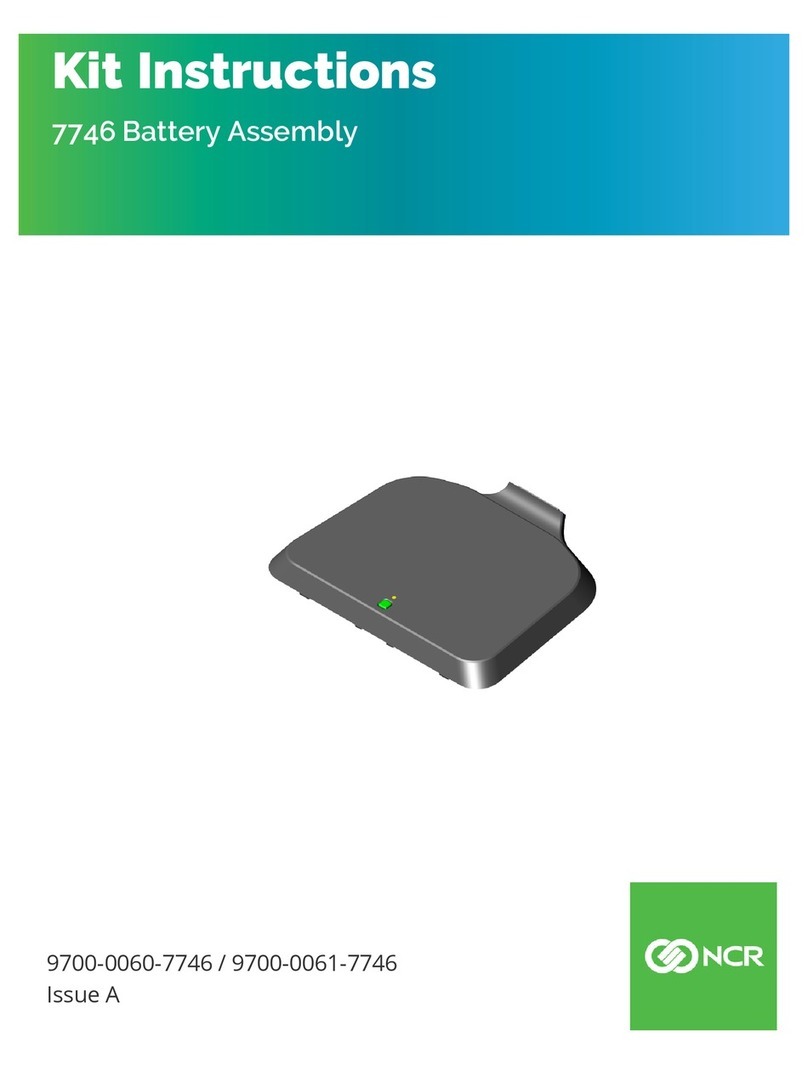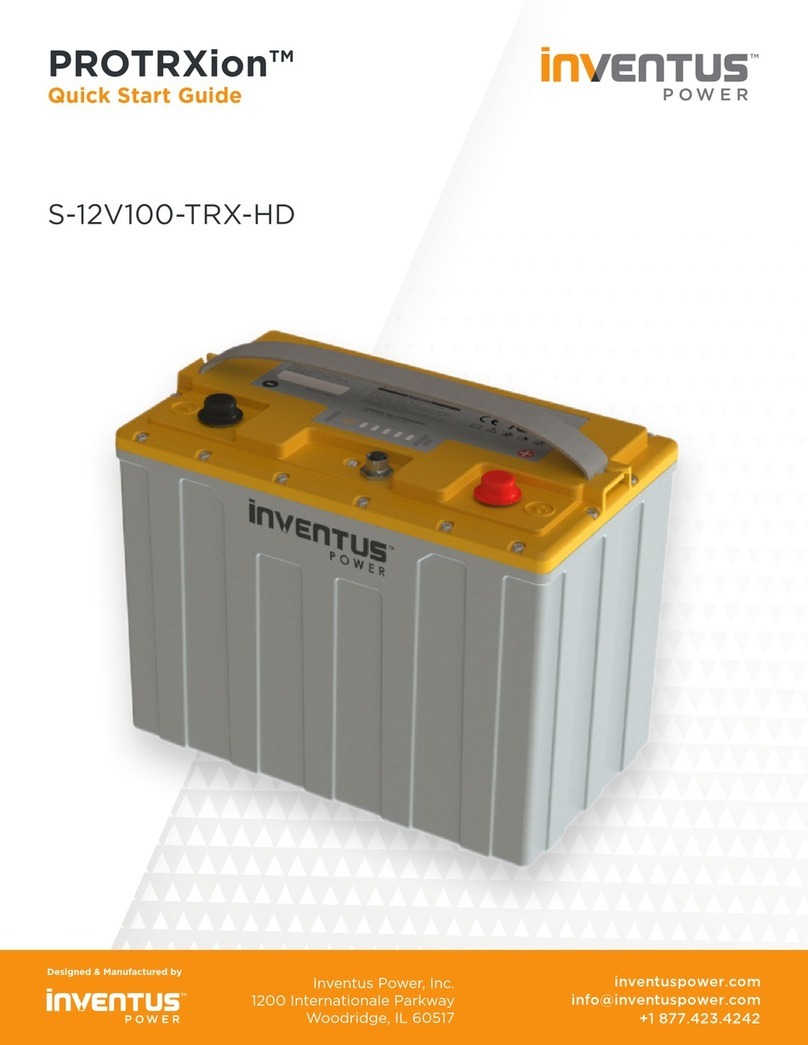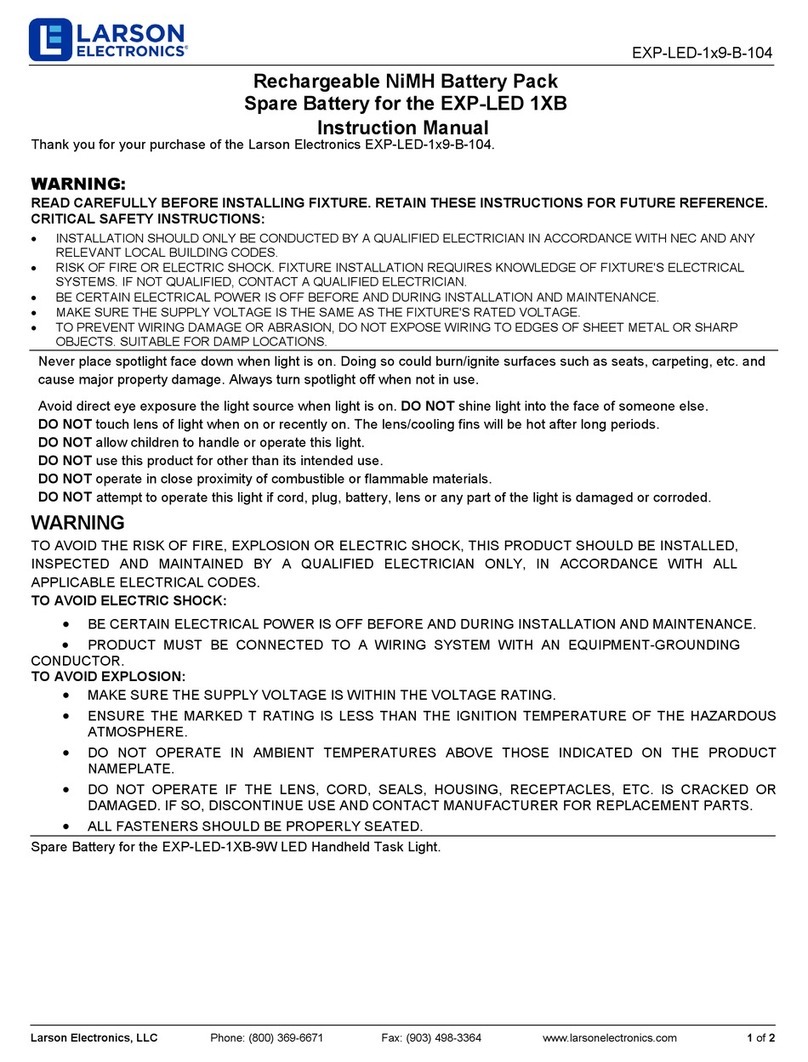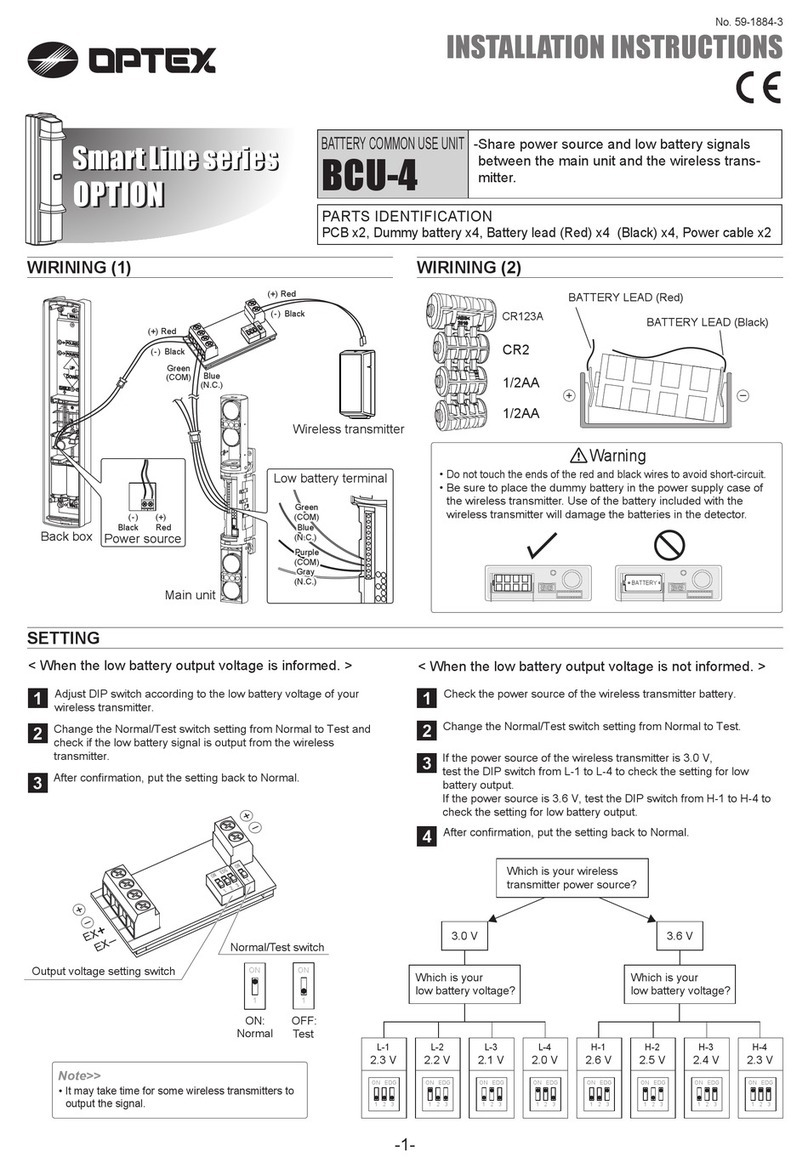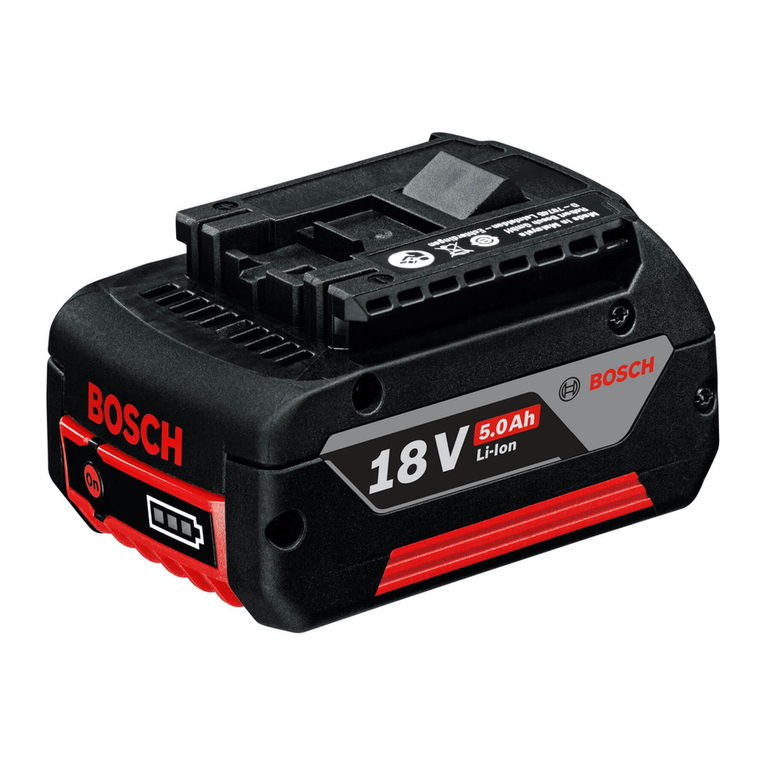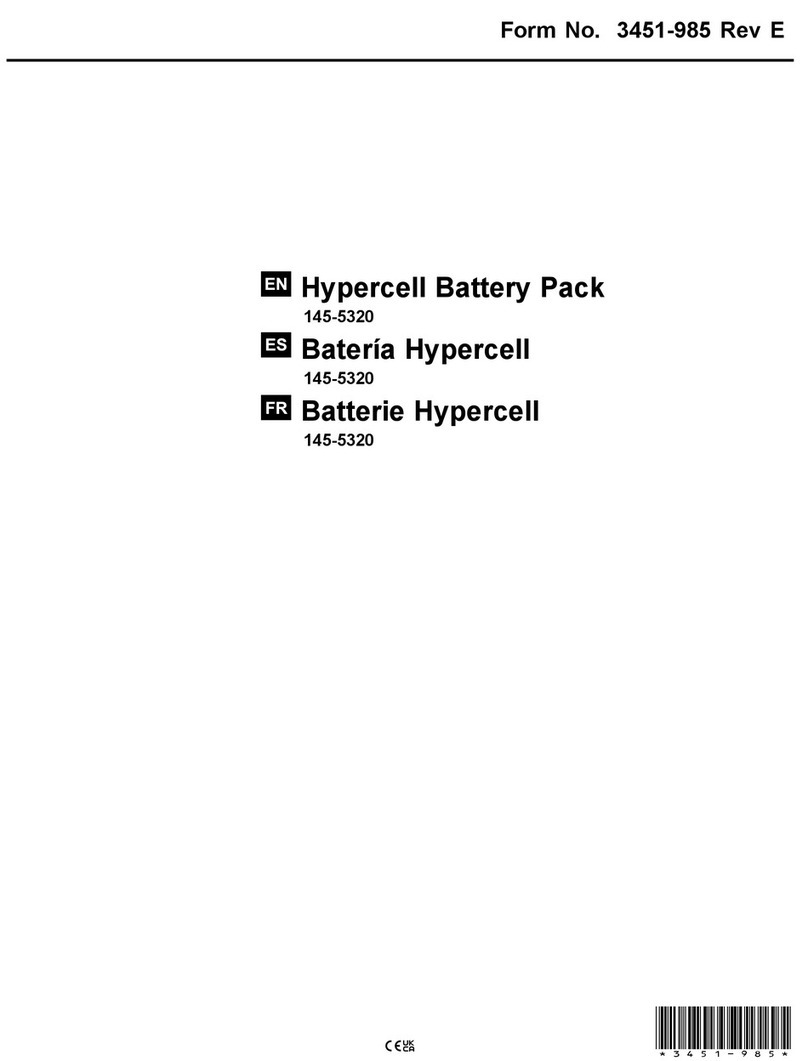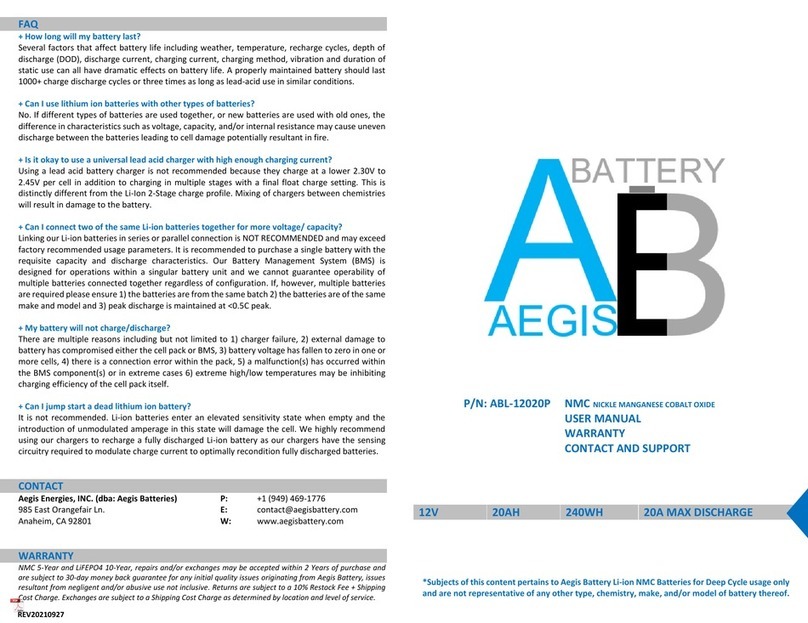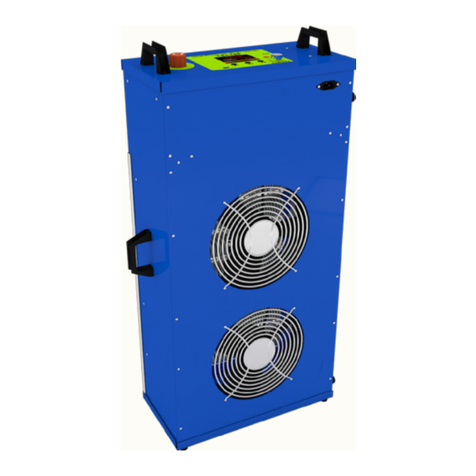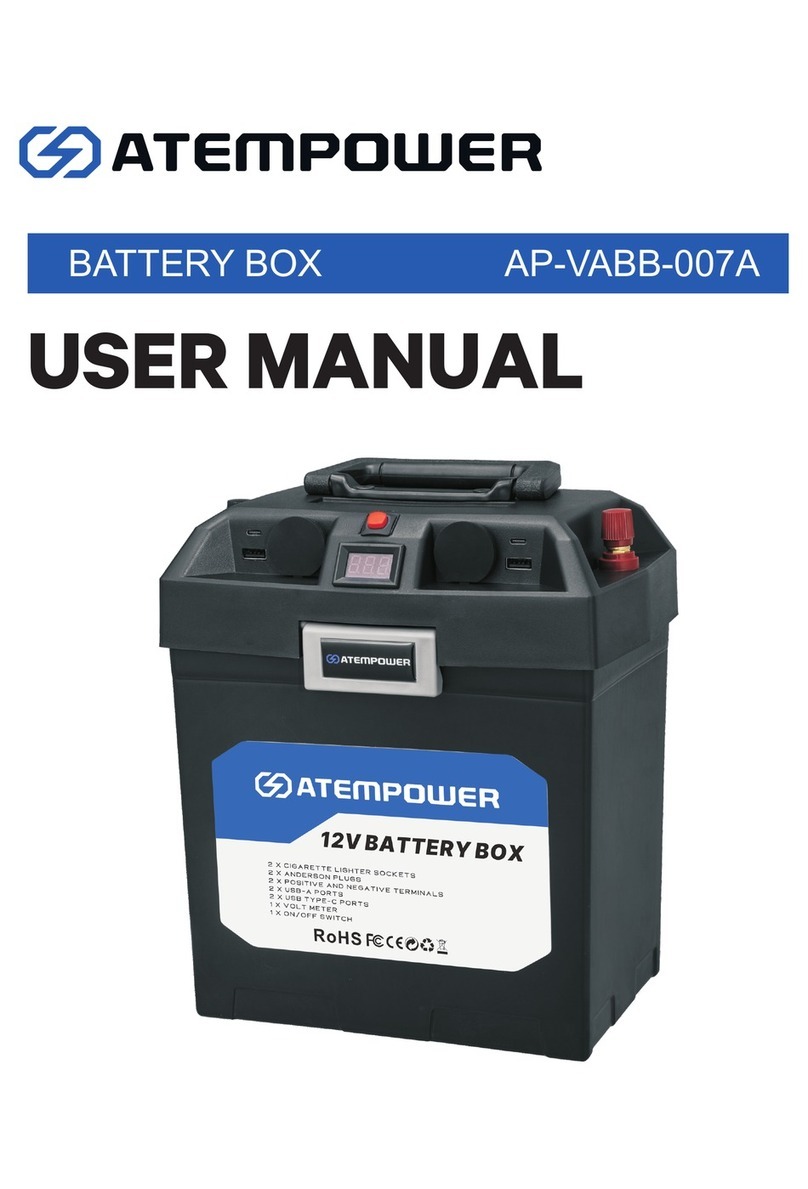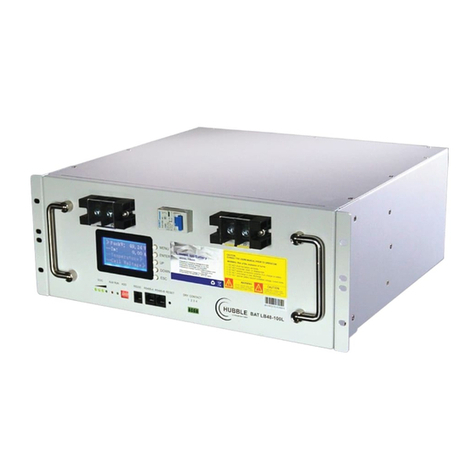FES GEN2 14S User manual

FES BATTERY PACK GEN2 14S, Version 1.23 September 2019
Page 2 of 26
Table of content
1. Important notices..................................................................................................... 3
1.1 Limited Warranty ................................................................................................. 3
2. General info ............................................................................................................. 4
2.1 Technical data ..................................................................................................... 4
2.2 Drawing .............................................................................................................. 5
2.3 General layout of the pack.................................................................................... 6
2.4 Internal BMS ....................................................................................................... 7
3. Battery pack Chargers .............................................................................................. 8
3.1 Available chargers................................................................................................ 8
3.2 Standard charger to Battery pack connection and charging .................................. 10
3.3 BMS Control software......................................................................................... 13
4. Before flight ........................................................................................................... 14
4.1 Installing the batteries ....................................................................................... 15
4.2 Preflight test run................................................................................................ 16
5. After landing .......................................................................................................... 18
5.1 Removing the batteries ...................................................................................... 18
6. Maintenance .......................................................................................................... 19
6.1 BMS firmware upgrade....................................................................................... 20
7. Transport............................................................................................................... 21
7.1 Car transport ..................................................................................................... 21
7.2 In glider trailer .................................................................................................. 23
7.3 Ship/train transport............................................................................................ 23
8. Storage.................................................................................................................. 24
9. Used packs ............................................................................................................ 26
10. Revision history .................................................................................................... 26

FES BATTERY PACK GEN2 14S, Version 1.23 September 2019
Page 3 of 26
1. Important notices
It is important to read this manual carefully before using the FES battery pack! It
contains important information about FES propulsion system, having a vital importance to
the flight safety. If you need more information, please contact the manufacturer of your
glider or FES manufacturer LZ design.
Information in this document is subject to change without notice. LZ design reserves
the right to change or improve their products and to make changes in the content of this
material without obligation to notify any person or organization of such changes or
improvements.
WARNING means that the non-observation of the corresponding
procedure leads to an immediate or important degradation of the flight safety.
CAUTION means that the non-observation of the corresponding
procedures leads to a minor or to a more or less long
term degradation of the flight safety.
NOTE draws the attention on any special item not directly related
to safety, but which is important or unusual.
1.1 Limited Warranty
This product is warranted to be free from defects in materials or workmanship for one
year from the date of purchase. Within this period, LZ design will, at its sole option, repair
or replace any components that fail in normal use. Such repairs or replacement will be made
at no charge to the customer for parts and labour. The customer shall be responsible for
any transportation cost. This warranty does not cover failures due to abuse, misuse,
accident, or unauthorised alterations or repairs.
THE WARRANTIES AND REMEDIES CONTAINED HEREIN ARE EXCLUSIVE AND IN LIEU
OF ALL OTHER WARRANTIES EXPRESSED OR IMPLIED OR STATUTORY, INCLUDING ANY
LIABILITY ARISING UNDER ANY WARRANTY OF MERCHANTABILITY OR FITNESS FOR A
PARTICULAR PURPOSE, STATUTORY OR OTHERWISE.
IN NO EVENT SHALL LZ DESIGN BE LIABLE FOR ANY INCIDENTAL, SPECIAL,
INDIRECT OR CONSEQUENTIAL DAMAGES, WHETHER RESULTING FROM THE USE,
MISUSE, OR INABILITY TO USE THIS PRODUCT OR FROM DEFECTS IN THE PRODUCT.
LZ design retains the exclusive right to repair or replace the unit or software, or to
offer a full refund of the purchase price, at its sole discretion. To obtain warranty service,
contact your local LZ design dealer or contact LZ design directly.
©LZ design. All rights reserved

FES BATTERY PACK GEN2 14S, Version 1.23 September 2019
Page 4 of 26
2. General info
This is standard FES Battery developed especially for FES application. In each battery
pack there are 14 cells, all wired in serial (14S). For standard FES application, always a pair
of such battery packs is required. One pack is marked as A and second pack as B!
We are using high power SLPB (Superior Lithium Polymer Battery) type of cells,
produced by global leader of Lithium polymer battery industry - Kokam Co.
Each Battery pack is equipped with internal BMS (Battery Management System) circuit
board which is fixed above the cells and is equipped with 14+2 LEDs to monitor its operation.
For + and - terminals we chose to use Amphenol Radsok hyperbolic high-power contact
technology. High current female contacts are hidden inside of the pack.
To avoid possible wrong connections there is 8mm contact for –pole and 10,3mm
contact for + pole.
2.1 Technical data:
Battery pack type
FES GEN2 14S
Weight of single battery pack
15,7 kg
Box dimensions (WxLxH), without terminals and ventilators
154 x 220 x 257mm
Cells producer
Kokam, South Korea
Electrochemical system
NMC (LiMnNiCoO2)
Cells type
SLPB100216216H
Average capacity of each cell
41 Ah
Number of cells
14
Energy storage capacity
2,1 kWh
Maximum total voltage
58,3 V
Minimum total voltage
42 V
Maximum current
250A
Max balancing current per cell
1A
Internal BMS type
FES-BMS-9R
Standard 600W small charger
FES KOP602
Optional 1200W biger charger
FES KOP1001
Optional 2300W fast charger
FES KOP2300
Optional 2000W fast charger
FES PR2300
FES GEN2 14S battery packs are suitable for next sailplane types:
-Ventus 3 FES, Ventus 2cxa FES, Discus 2c FES (produced by Schempp-Hirth, Germany)
-HPH 304 ES (produced by HPH Sailplanes, Czech Republic)
-LAK17B FES, Mini LAK FES (produced by SAirKo, Lithuania)
-Silent 2 Electro (produced by Alisport, Italy)
-Diana 2 FES (produced by Avionic, Poland)
-LS8 e-neo (produced by DG flugzeugbau, Germany)
-AS13,5m FES (produced by Albastar, Slovenia

FES BATTERY PACK GEN2 14S, Version 1.23 September 2019
Page 5 of 26
2.2 Drawing

FES BATTERY PACK GEN2 14S, Version 1.23 September 2019
Page 6 of 26
2.3 General layout of the pack:
Top view of FES GEN 2 battery pack
Plus pole
RADSOK
terminal (fi
10.3mm)
Minus pole
RADSOK
terminal (fi
8,0mm)
DATA cable
connector,
with spring
locks
BMS ON-OFF
switch
Balancing LEDs 1-14
»BMS POWER«LED
»ERROR«LED
Strap for carrying
BMS cooling
plate
ventilators

FES BATTERY PACK GEN2 14S, Version 1.23 September 2019
Page 7 of 26
2.4 Internal BMS
FES GEN2 battery pack is equipped with BMS (Battery Management System)
electronic circuit.
How BMS works?
BMS electronic measure and control voltage level of each cell in the battery pack.
During charging and discharging, battery cells differ in voltage levels, due to slightly different
capacity of the cells. Cells with lower capacity become fully charged faster than cells with
higher capacity. Those cells which reach maximum preset voltage earlier than the others,
are discharged through resistors inside of BMS –the energy dissipates through heating of
the upper cover plate, which is milled from Aluminum, and black anodized. To improve
dissipation of the heat there are two small ventilators on top of the upper plate which starts
running when upper plate reach preset temperature (50°C)
Balancing of each cell is indicated by green light emitting diode (LED).
Note: BMS starts balancing cells only during charging, and above pre-set
balancing start voltage (4.10V)
BMS DATA AND INITIAL SETTINGS
Parameter
Value
Unit
Maximum charging current**
9,18 or 35
A
Maximum balancing current
1
A
Single cell end of charge voltage*
4.16
V
Single cell balance voltage start*
4.10
V
Single cell balance voltage end*
4.16
V
Single cell under-voltage protection*
3.1
V
Single cell over-voltage protection*
4.18
V
Cooling fans start temperature*
50
°C
Max BMS temperature*
55
°C
*Initial settings may be changed with BMS Control software.
**Max charging current depends on type of charger.

FES BATTERY PACK GEN2 14S, Version 1.23 September 2019
Page 8 of 26
3. Battery pack chargers
For charging of FES battery packs, only special FES chargers as described below are
approved. If your country is using 110V~ grid, then you should use suitable voltage step up
transformer for chargers which required input voltage 230V~ 50/60 Hz.
Note: Each charger is preset with suitable settings for FES GEN2 14S and
works only if it communicates with BMS circuit board inside of the battery
pack.
3.1 Available chargers
1. FES KOP602 - standard equipment
- FES system comes with two chargers FES KOP602
- maximum charging current 9A
- required input voltage is 230V~ 50/60 Hz
KOP 602 BMS Charger
2. FES KOP1001 - optional charger
- maximum charging current 18A.
- required input voltage is 230V~ 50/60 Hz
KOP1001 BMS Charger

FES BATTERY PACK GEN2 14S, Version 1.23 September 2019
Page 9 of 26
3. FES KOP2300 - optional charger
- 2300W; 5,6 kg
- maximum charging current 45A.
- required input voltage is 80V - 265V~ 47/63 Hz (suitable for US customers as it works on
110V~)
4. FES R2300 BMS version –optional charger
- 2000W; 6,1 kg
- with maximum charging current 35A.
- required input voltage is 230V~ 50/60 Hz
FES R2300 charger

FES BATTERY PACK GEN2 14S, Version 1.23 September 2019
Page 10 of 26
Note: Before using the charger, check if the fuse on the grid is suitable.
For 1200W charger it should be minimum 10A fuse.
For 2300W charger it should be minimum 16A fuse.
High power chargers must be connected directly to inlet, without extension
cables and splitters.
Warning:
If you have another pair of Battery pack, make sure that you do
not mix packs between the two sets. The same two packs of one set (first
marked as A, second marked as B) must be always used in pair!
3.2 Standard charger to Battery pack connection and charging
Caution: Place charger on a safe, secure position. Keep away from dust, direct
sunlight, fire, smoke, childrens and any unatendent person!
Warning:
Before charging, physical condition inspection of the battery packs
should be done. Any sign of mechanical damage, such as a puncture, dents,
scratches, must be evaluated and reported to manufacturer before charging.
1. Connect RED + and BLUE - cables from charger to first battery pack.
2. Connect charger and Battery pack with BMS-Charger communication cable.
BMS-Charger communication cable (KOP601, KOP1001)

FES BATTERY PACK GEN2 14S, Version 1.23 September 2019
Page 11 of 26
3. Plug in charger to outlet (220V AC, 50-60hz).
4. Turn on BMS switch on top of the Battery pack cover.
Immediately after BMS is switched ON, the BMS starts test procedure - with check of
all 14 cells, one by one. Red »Error LED« turns ON during system's test procedure
and switch OFF again when test is completed without error.
After test procedure, certain number of LEDs turns ON for about 1 second.
Number of cells which turned ON represents battery pack state of charge - SOC.
Each LED which turns ON represent about 7% SOC:
-if 1-2 turn ON, this means than battery pack state of charge is approximately 14%.
-if 1-7 turn ON, this means than battery pack state of charge is approximately 50%.
-if 1-14 turn ON, this means than battery pack state of charge is approximately 100%
5. When test procedure is completed also a green »Power LED« starts blinking, which
is clear sign that BMS starts working in normal mode. At the same time, BMS sends
signal to the charger to start charging. Orange LED on front panel of the charger
starts burning, which indicates charging. It is also possible to hear contactor "click"
inside of the charger. Charging current rises slowly to the final value of 9 A (or 18A
at 1200W, 35A at 2000W version), and after some time, cooling fans in charger starts.
6. In normal mode green »BMS Power« LED of BMS is starting flashing. This means that
the BMS is turned ON, but not necessary balancing. Balancing starts when one cell
reaches pre-set value, usually 4,1V (could be changed by BMS Control Software). If
any of 14 green LED cell balancing indicators is ON, it means that this cell has slightly
higher voltage compared to the lowest one.
1. If one or just a few cells have higher voltage levels that the others, BMS will
discharge them, the BMS temperature rise will be minimal.
2. In case that one cell has lower voltage level than the others, all higher cells will
need to be discharged so that at the end all of them will be balanced. This leads to
higher BMS temperature rise, even if voltage difference is only 0.010 V (10mV).
The cooling ventilators start working if an upper BMS cooling plate of
battery pack reaches 50 °C
Caution: Sometimes in hot conditions, temperature of the BMS cooling plate
could still rise despite of working ventilators. In such case when the
temperature of cooling plate would reach 55 °C, the charger would be
switched off automatically. When the temperature drops down to 45 °C, the
charger would start charging again.
7. Red »Error LED« is ON only during the initial test procedure. After the test is finished
it turns OFF. Some system errors are also indicated with red »Error LED« by the
number of ON blinks, followed by a longer OFF state. Number of blinks identifies the
error.

FES BATTERY PACK GEN2 14S, Version 1.23 September 2019
Page 12 of 26
8. When first cell reaches 4.160V, charging current is reduced. If there is a big difference
between cells (more than 50mV) then it can take quite long until they all reach 4,16V,
as charging current is only 1A.
9. When finally, all cells reach 4.160V (+/- 2mV), then BMS send a signal to charger
to stop charging.
At this point Green “Power LED” stops flashing and become continuously Green.
This is a clear sign that charging cycle is properly completed!
10. Switch OFF BMS on top of the Battery pack. Unplug charger from outlet. Unplug
charging cables and signal cable from Battery pack.
11. Charge second FES GEN2 battery pack!
Warning:
Both battery packs must have approximately the same cell voltage
levels (close to 4.16 V per cell), before usage. Using two packs with too much
difference in voltage levels is not allowed!
Maximum 1V difference between total voltages of both packs is acceptable.
For instance, Pack 1: 58,1V (average 4.150 per cell), Pack 2: 57,1V (4,080V
per cell), this is just acceptable! Bigger voltage difference is not acceptable!
Caution:
When thunderstorm is approaching, stop charging immediately and
disconnect the charger from the wall.
List of red error codes:
Number of red blinks
Error description
1
Single or multiple cell voltage is too high (4.2 V) *
2
Single or multiple cell voltage is too low (3.24 V) *
3
Cell voltages differ more than preset value (0.5 V) *
4
Cells temperature is too high (>55 °C) *
5
BMS temperature is too high (>50 °C) *
6
Number of cells is not set properly
7
Too low temperature for charging < -1°C
8
BMS do not recognize temperature sensor
9
Communication error
10
Measurement of cell below 0,1V or above 4,8V
13
Wrong chemistry set by BMS control software
*Initial settings may be changed with BMS Control Software.

FES BATTERY PACK GEN2 14S, Version 1.23 September 2019
Page 13 of 26
3.3 FES BMS Control software
If you want to monitor and log how voltage levels of each cell in the battery pack are
rising during charging, you can use dedicated FES BMS Control software on PC (or via
optional FES LCD display).
In case that some problems are discovered during charging, log file can be created
and later you can send it by email to FES manufacturer. It can help us to discover the
problem and find a suitable solution.
How to install and use FES BMS Control software is described step by step in
dedicated FES BMS Control manual, which can be obtained from FES dedicated website, in
download section.
Cells voltage levels, and calculated internal resistance values on fully charged battery pack

FES BATTERY PACK GEN2 14S, Version 1.23 September 2019
Page 14 of 26
4. Before flight
Valid for FES Self-launchers:
For self-launching FES battery packs must be always recharged, so that maximum power
for good climb rate is available. This is especially important for:
- cold batteries, when voltage drop under high power load is bigger
- short runways
- high altitude runways
- hot summer conditions
Valid for FES Self-sustainers:
Before each flying day, battery packs should be recharged, especially if motor was
significantly used during previous flights, and long cross-country flight is planned; so that
maximum energy will be available when needed.
Note: It is recommended to recharge Battery packs just a day or two before
flight is planned. However, plan charging so that there will be enough time for
properly completed charging process!

FES BATTERY PACK GEN2 14S, Version 1.23 September 2019
Page 15 of 26
4.1 Installing the batteries
Warning: Make sure that both battery packs are fully charged before
installation into sailplane. Both battery packs must have approximately the
same voltage level of each cell (close to 4.16 V per cell). There should be less
than 1V difference, between total voltage levels of each battery pack!
1. Check batteries for any visual damage.
Warning: Even small visually detectable damages imply that the affected
battery is not airworthy.
2. Open battery compartment cover.
3. Check: “Power switch”OFF.
4. Check: Sailplane main switch (fuse) OFF.
5. Insert first pack (terminals facing forward) and slide it back to rear position.
6. Insert second pack (terminals are facing rearward).
7. Place pair of fixation plates in the middle of rear pack, above carrying strap and
tighten fixation knob.
8. Secure forward battery in the same way.
9. Lift power cables from side support.
10. Plug in shorter cable, with 8mm pin in BLUE (or BLACK) housing, to minus marked
8mm socket of front battery pack.
11. Plug in longer cable with 10mm pin in RED housing, to plus marked 10mm socket of
rear battery pack.
12. Insert DATA cable connectors, to each battery pack DATA connector.
Caution:
Prior to insert DATA cable connector make sure that the orientation
is correct. Connector should be plugged in straight direction, otherwise pins
could be damaged.
13. Close battery compartment cover.
Warning:
In flight the battery compartment cover must be sealed with tape.
If water could possibly enter in the battery compartment on the ground (e.g.
rain shower or when cleaning), then also on the ground the battery
compartment cover must be sealed. Entering water, even in small quantities,
could damage the batteries.

FES BATTERY PACK GEN2 14S, Version 1.23 September 2019
Page 16 of 26
4.2 Preflight test run
After battery packs were recharged, it is always required to perform short motor
run, so that FCU instrument can recognize recharge and new charge level is stored to the
FCU memory.
Short motor run is also recommended before first flight in flying day.
1. Remove propeller covers and tail dolly.
2. Open battery compartment cover.
3. Check: Power switch OFF.
4. Switch ON the BMS on each battery pack and wait until initial check is completed.
5. Insert connecting cable between the front pack + terminal, and rear pack –terminal.
6. Close battery compartment cover and seal it with tape.
7. Seat into the cockpit of the glider and close canopy.
8. Check that nobody is in line of propeller disk or in front of sailplane.
9. Switch ON the FCU and wait a few seconds until appearance of normal screen.
10. Switch ON the Power switch.
11. Wait about 5 seconds so that charge level (indicated as bottles) reaches
100 % value (this happens only if total voltage is above 114V).
12. Gently rotate throttle knob clockwise to start motor. Use only small RPM, just to check
if system works normally.
Caution: New battery charge level will be stored to the FCU memory, only if
motor is started, for short time.
13. Check if automatic positioning is working properly.
14. Switch OFF the Power switch.
Standard type of “Connecting cable”, as used on most FES systems.

FES BATTERY PACK GEN2 14S, Version 1.23 September 2019
Page 17 of 26
Top view of right-angle type of “Connecting cable”, as used on LAK gliders.
Bottom view of right-angle type of “Connecting cable”, as used on LAK gliders.

FES BATTERY PACK GEN2 14S, Version 1.23 September 2019
Page 18 of 26
5. After landing
Warning:
After last landing in flying day (or if you decided not to fly) it is
mandatory to unplug “Connecting cable”, from the battery packs!
At the same time, also both BMS switch on top of the battery packs, must be
switched OFF.
Caution: Make sure that “Power switch”is OFF before removing connecting
cable.
Note: Only when connecting cable is unplugged, FES system is completely
shut down. Otherwise there is still some current consumption, which could
result in discharge of battery packs, below critical level of 90V, if connecting
cable is left connected for a week or two. After such scenario, a new battery
packs would be required.
5.1 Removing the batteries
When battery packs total voltage drops below 110V, it is suitable to take them out of
the glider and recharge them shortly before next flight is planned.
To remove batteries next procedure should be followed:
1. Check: Power switch OFF.
2. Check: Sailplane main switch (fuse) OFF.
3. Open battery compartment cover.
4. Remove the Connecting cable from terminals of battery packs.
5. Remove red and black power plugs from battery packs.
6. Fix both power cables on right side of battery compartment wall.
7. Remove DATA connectors from each battery pack.
8. Fix DATA cable to side of battery compartment.
9. Unscrew both battery pack fixation knobs.
10. Take all fixation plates out.
11. Firmly grip the front battery by a carrier strap.
12. Lift the battery pack out of the fuselage and put it on a safe place.
13. Firmly grip the rear battery pack by the carrier strap und slide it forward along the
bottom of the compartment.
14. Lift the battery pack out of the fuselage and put it on a safe place.
15. Close battery compartment cover.
Caution: For transport and storage of the batteries always a transport box or
something similar must be used which protects the batteries from mechanical
damage. Make sure you put battery packs on a dry and safe place. Read FES
Battery pack manual section 7 and 8 for further instructions.

FES BATTERY PACK GEN2 14S, Version 1.23 September 2019
Page 19 of 26
6. Maintenance
With proper and carefull use of FES battery packs, there is practically no maintenance
required. FES battery packs are built from the most suitable cells available, so that they can
provide high power and good endurance and will serve you for many years and charging
cycles.
Note: Unfortunately, some capacity deterioration will occur due to aging of
the cells whether the battery packs are in use or not. The useful life of a lithium
cells is based on several factors which can prevent the battery from providing
sufficient current draw due to increased internal resistance.
Suitable uses and treatment that will reduce deterioration include:
1. During powered flight, use low power settings as much as possible and practical.
2. Do not discharge cells below 3,4V (total voltage at 95V), if it is not really neccessary.
3. Store battery packs at suitable temperatures when they are not in use (review next
chapter 7. Storage)
4. Store battery packs at suitable charge levels (around 50% SOC, see next chapter 7.
Storage)
Good indication of the battery packs condition is SOH –State of Health % parameter,
which can be read in lower right corner of BMS control software. It is calculated from
average internal resistance of the cells, measured during charging, and number of charging
cycles.
With poor treatment of the battery packs, their cells internal resistance will be rising
faster, and so calculated SOH % level will become lower. When it will be as low as 50%, it
would be time to think about replacement of the battery packs (at least the cells, BMS
electronic could be reused).
Poor condition of the cells can be recognizable also during powered flight:
- much deeper voltage drops at max power settings,
- much reduced maximum achievable power (with fully charged packs),
- much reduced usable capacity –altitude gain and range of level flight,
- temperature rise gradient of the battery pack will become much faster.
Note: We suggest replacing FES battery packs, when maximum available
range of level flight (to reach 90V or 55°C, whatever first), is reduced to one
third of the range experienced when they were new. Probbably there would
be not much sense to utilize them further on in such conditions.
Please handle FES battery packs very carefully to avoid mechanical damage of
housing. Only if battery packs are free of any damages it is allowed to charge them and
then install them into the glider. They must be always visually inpected before each charging
and before installation to the glider. This is even more important when glider is used by a
syndicate of pilots or in aeroclubs. If the housing is found to be damaged, somethimes also
cells inside might be damaged, which could be dangerous. In such case please contact
manufacturer, for evaluation of damage and further steps.

FES BATTERY PACK GEN2 14S, Version 1.23 September 2019
Page 20 of 26
6.1 BMS firmware upgrade
From time to time there might be available new improved version of BMS firmware.
It is easy to perform upgrade, by using provided BMS-Charger-PC cable, and BMS Control
software which is available to download from FES dedicated website.
If there is any strange behaviour of BMS, upgrade usually resolves the problem.
To perform upgrade it is required suitable .bin file, which we can send to the customer
by email. Please save it to the chosen location on PC disk drive.
Connect BMS-Charger-PC cable to BMS and to USB port of PC. Run BMS Control
Software, cancel any initial error messages which might appear (note that for firmware
upgrade green PRESENT indication is not required). From upper menu choose BMS, then
Firmware upgrade and browse for .bin file where you save it on PC (named like: BMS_9R-
2.22.bin). Switch ON, the BMS switch on top of the battery pack. Wait until programming
will reach 100% in progress window. BMS will restart itself and start working normally.
Other manuals for GEN2 14S
1
Table of contents


